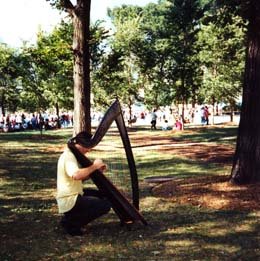Grant Park Celtic festival and marijuana rally

“ It is suicide to be abroad. But what is it to be at home...what is it to be at home? A lingering dissolution.”
Samuel Beckett.
American self confidence
In Wales we are riddled with self-doubt. We are afraid of “bettering ourselves” lest we fail, or we are thought by our close knit community to want to change our status in life, to be different, to “get on”.
”Giving herself airs and graces” they whisper in the valleys. So we settle for mediocrity . At least its cosy.
Imagine the shock to arrive in a country that not only believes in itself but shouts it from the rooftops.
“You can make it!” seems to be tattooed on every teenagers arm.
This is “the American Dream”.
Everyday 63 millionaires are made in Silicon Valley and all are under 30 years of age. Chicago University has t-shirts proclaiming the number of Nobel Prize winners it has produced. 74 at the last count.
This is a place where possibilities become realities.
To get there, start here...

During my first few weeks I wander around in a daze : can it really be this good? where are the cracks?
One Saturday afternoon I find myself in Grant Park, often described as Chicago’s “front yard”, a huge public park running parallel with the lake. Back in 1835 some foresighted citizens lobbied to protect this open space against development and in 1901 it got its present name after Ulysses S. Grant, the 18th President of the United States. Today its the venue for all kinds of events as well as housing three world class museums, The Art Institute, the Field Museum of Natural History and the Shedd Aquarium.
Today there’s a huge demonstration taking place with
a massive police presence. The Chicago police look so fearsome that I think twice before approaching them. But I say to myself:”
“This is stupid! these guys are there to protect us.” So I approach one, a big Afro-American, who looks more friendly than some of his colleagues.
"What's going on?"
"Marijuana rally," he replies.
"You mean?...to legalise?"
He nods.
Whereupon as if on cue a young woman leapt on to the platform.
She has a clean wholesome look about her: healthy, robust, confident, the epitome of young American womanhood. Any mother would be proud of her.
She grabs the microphone in a surprisingly aggressive manner.
"I got busted when I was 16 years of age!"
Cheers and applause from the crowd.
"But I was a good student, and I came from a good home so they put me on probation. They wheeled out all the experts. They could find nothing wrong with me. They said I was sane. I was perfectly normal. Then this psychologist said to me:
"When did you last smoke marijuana?"
"On my way here sir!"
Thunderous applause. The crowd go hysterical, cheering and clapping. More speeches follow from other speakers all eulogising the power of the weed. Its a peaceful rally and even the police seem laid back.

Only the week before on this same patch of ground I sat through the annual Celtic Festival, listened to bagpipes, Gaelic singing and joined in as we Celts tried to find tour roots. And I had failed miserably. Irish and Scots galore! but Welsh? forget it.
There’s no discernible Welsh presence in Chicago, at least not at the Celtic Festival though the history of the city reveals that one of Al Capone’s henchmen was a man by the name of Evans, noted for his silver tongue and the present President of the School of the Art Institute, Tony Jones, is a Welshman too.
On my way home walking through the Loop I see my first case of panhandling, outside Borders Bookshop .
"There's one!"
Something in the tone of the voice, the sense of urgency, made me stop and look back over my shoulder in time to see two young Afro-Americans approach a woman sitting on the wall outside the bookshop.
Suddenly I saw her through their eyes: a middle-aged woman sitting alone wearing a voluminous pastel skirt, floral blouse, flat shoes and clutching a big handbag.
A sitting target. She might as well have been carrying a placard: "I'm a tourist. Rob me."
So they did.
They walked straight up to her, stopped in front, and the smaller of the two boys held out his hand:
"Give us some money."
Obediently, she opened her purse.





